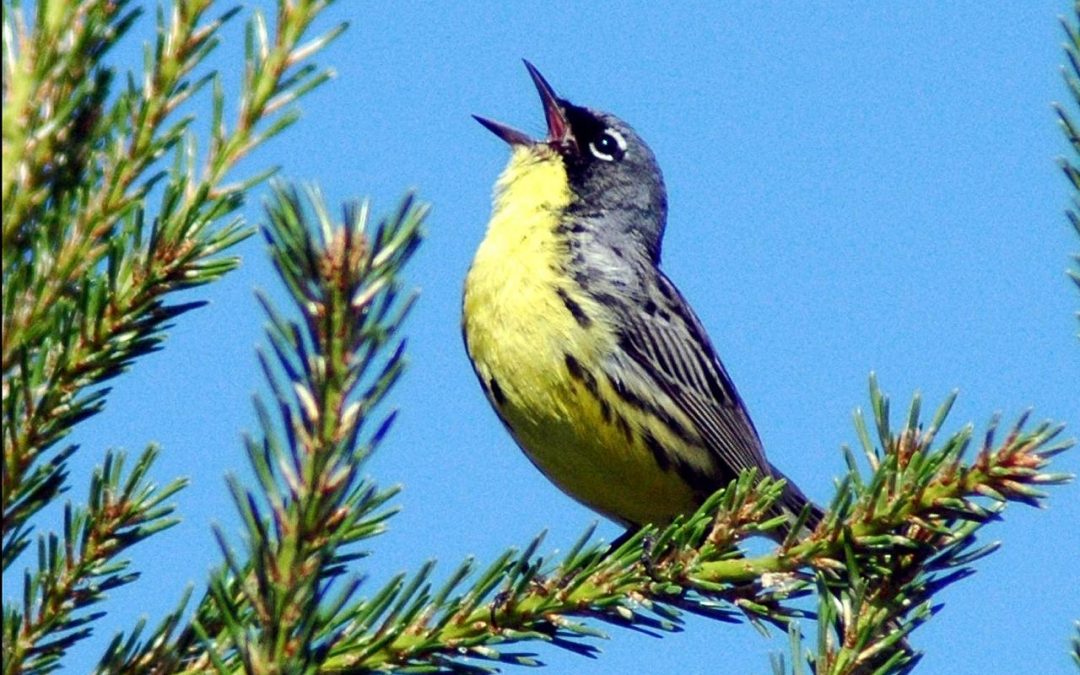If you’ve spent much time in deep woods or around wetlands, you will know that it’s common to hear many more birds than you can see. And sometimes, when those hidden birds finally do come into the open, it’s only for a brief glimpse before they drop back down into cover.
At times like these, the birdwatcher’s best strategy is to rely less on visual cues and concentrate on the sounds made by the birds. Just like their plumage is unique to each species, so are the songs they sing. Being able to identify a bird by their song allows you to identify the species you can hear but cannot see.
The ability to identify birds by their song alone is a very rewarding skill but one that is not easy to master. Learning to bird by ear requires a different set of skills than those used to identify birds by sight. Bird songs can be fast, fleeting and somewhat confusing, even without considering that many species exhibit considerable variation in their songs.
Listening to audio tapes, CD’s or MP3’s of bird songs is a great way to begin learning the songs of different birds. And when you are out in the field, putting a visual identification to a specific song will help further ingrain that song into your memory. If you are like most birders, you will need to hear the songs many, many times.
As useful as bird song recordings may be, you should be aware that variations in song types for one species can be as great as are the variations in their plumage. This is especially true for sparrows, whose plumage and song type can be strikingly different when individuals at one end of their range are compared to individuals at the other end.
One trick many birders use to recall a song for a particular species is to use mnemonics; assigning short phrases of words to a song. These short phrases will fit with the music of the bird song and serve as a mental signpost so that when you hear the song, the phrase will pop up into your memory, in the same way that some commercial jingles on TV remind you of a certain kind of breakfast cereal.
An example of a common mnemonic is used for the stereotypical Hollywood owl found in so many movies: Hoo hoo hooooo.
More specific mnemonics can be applied to every songbird species. A few of the more commonly used mnemonics are listed below.
Acadian Flycatcher – pizza
Alder Flycatcher — fee-bee-o
American Goldfinch — po-ta-to-chip
American Kestrel – killy killy killy
Blue Jay — queedle-queedle-queedle-…
American Robin — cheer-up, cheer-a-lee, cheer-ee-o
Baltimore Oriole — here, here, come right here, dear
Barred Owl — who-cooks-for-you, who-cooks-for-you-all
Black-and-White Warbler – weese weese weese weese
Black-capped Chickadee — chik-a-dee-dee-dee
Black-throated Blue Warbler – see see see see see
Black-throated Green Warbler – trees, trees, murmuring trees
Black-throated Green Warbler – 1, 2, 3, I’m lazy
Bobwhite – bob-white, bob-white
Carolina Wren – teakettle teakettle teakettle
Chestnut-sided Warbler – very, very pleased to meet-cha
Common Nighthawk — beeeer
Common Yellowthroat – witchety-witchety-witchety
Dark-eyed Junco — riiiiing riiiing (like the ring made by an old rotary phone)
Eastern Meadowlark – spring of the year
Eastern Phoebe — fee-beee
Eastern Wood Peewee – Peee-a-weeeee
Gray Catbird — meeeee-ew
Great Crested Flycatcher – Wheeeep-wheeeeep
Great Horned Owl — who’s awake? me too
Greater Yellowlegs — dear, dear, dear
Indigo Bunting – Fire, fire! Where,where? Here, here! Put-it-out, put-it-out!
Killdeer — kill-deeeeer kill-deeeeer
Laughing Gull — ha-ha-ha-hahaha-hahaha
Least Flycatcher – Che-bec, che-bec
Long-billed Curlew — ker-leww
Magnolia Warbler — I’m-I’m-I’m-so-sweet
Mourning Dove — hooo-ah hoo-hoo-hoo
Mourning Warbler — turdle, turdle, turdle, two-to-you
Nashville Warbler – Seebit, seebit, seebit, seebit, tititititi
Northern Flicker – Flicka, flicka, flicka, flicka, flicka
Northern Oriole – Here, here, come right here, dear
Northern Waterthrush – Nice old ladies don’t choo choo
Olive-sided Flycatcher — quick, three-beers
Ovenbird — tea-cher, tea-cher, tea-cher
Red-eyed Vireo — where are you? here I am, way up here
Red-winged Blackbird — conk-a-reeeeeeeee
Rose-breasted Grosbeak — cheer-up, cheera-lee, cheer-ee-o
Rufous-sided Towhee – Drink-your-tea-ee-ee-ee
Song Sparrow — Maids maids-maids-put-on-your tea-kettle-ettle-ettle
Song Sparrow — Hip, hip,hip hurrah boys, spring ishere!
Song Sparrow — Madge, Madge, Madge pick beetles off, the water’s hot
Tennessee Warbler — tikatika-tika, swee-swee-swee, chay-chay-chay
Tufted Titmouse – Peter, peter, peter
Vesper Sparrow — listen tomy evening sing-ing-ing-ing
Warbling Vireo – Iggley, pigelly, wigelly, pig
Whip-poor-will – whip-poooor-will, whip-poor-will
White-breasted Nuthatch – yank, yank, yank
White-crowned Sparrow — more, more, more cheezies, please
White-crowned Sparrow — oh dear Canada Canada Canada
White-crowned Sparrow — dear Sam Peabody Peabody Peabody
Willow Flycatcher — fitz-bew
Worm-eating Warbler – If I see him, I’ll squeeze him, and squeeze him til he squirts
Yellow-throated Vireo – three-eight
Yellow Warbler — sweet sweet I’m so sweet
And of course, the species with the most complicated of bird vocalizations:
Mallard — quack

